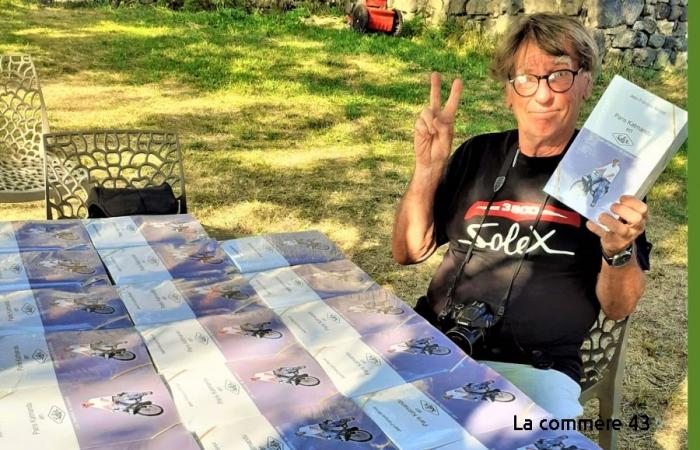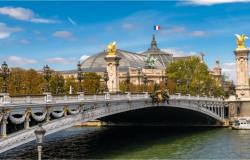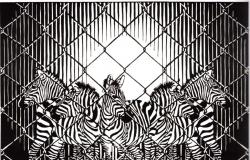A year after the events of May 68, traveling by Vélosolex to Nepal from the capital seemed like a crazy idea. However, Jean-François Monod and Philippe Bissières did it. Jean-François had written everything down in a notebook that had remained in drawers. Of course, they had made some reproductions of their journey on their return. The meeting between Jean-François Monod and the publisher Bruno Salgues brought these unpublished notes back to life in a book that has just been published by Cap de l’Etang Editions: “Paris Katmandu en Solex, Les chemins de Baklava”.
Jean-François recounts this extraordinary journey of more than 10,000 km. Together, they crossed 9 countries: Germany, Austria, Yugoslavia, Bulgaria, Turkey, Iran, Afghanistan, Pakistan, India and Nepal. This journey would be almost impossible to achieve today, due to the presence of conflicts and also, for example, the presence of the Taliban.
Take his moped, fill the tank with Solexine, and load some 50 kilograms of luggage into the panniers, then set off, such was the crazy plan that consisted of joining Kathmandu to Nepal.
Preparation is essential
To prepare for this trip, Jean-François first tested a Paris-Istanbul, then he worked at Solex where the pay slip was 580 francs at the time, in order to fully understand the machine, because you have to be able to master the mechanics on such a long journey.
Preparation is also mental. “In such an adventure, we live to the rhythm of our body, the weather and the moped,” say the two travel companions. You have to mentally accept such a journey. If the moped forces you to live at its speed, it allows you to take the time to observe the landscapes. The project required living for several days in total autonomy: “That’s part of the adventure. Sometimes you have to look for water and food, because in some sparsely populated places, there is almost nothing,” they remember. Crossing the desert is a hell of dust that transforms men and machines into animated stone sculptures.
“It’s the best way to travel,” says Jean-François Monod, a solex aficionado.
On a moped, the landscapes pass by at an almost natural speed, faster than walking, slower than driving or taking the train. It’s the best way to travel. It allows you to observe, to pay attention to details. But sometimes, this naturalness overwhelms us when the dust raised by the road transforms us into a masked character and prevents us from seeing anything.
This trip was out of the ordinary. “We didn’t want to take the car, or do part of the trip by plane. As for the first solution, we only saw constraints. As for the plane, it was excessively expensive.” At that time, ecological motivations were not in vogue. For them, the trip by solex was simply a philosophy.
Improvisation is not an option. They already had experience on a trip to Turkey, so the preparation was quick. The two friends worked on the itinerary for a few hours. In this type of travel, there is still a large part of improvisation in the face of climatic, administrative and also mechanical hazards. The flexibility that must be left to this kind of adventure gives a feeling of freedom.
Traveling in this way means living to the rhythm of the days, but also to the possibilities of the bodies of those who undertake such a journey. Between Paris and Kathmandu, they slept a number of times in bales of straw. Photographs confirm this perilous situation. From time to time, the adventurers treated themselves to a night under a roof to recharge their batteries. Sometimes, these were unusual places that allowed them to meet the inhabitants of the towns and villages they passed through. These were immediately sketched in the notes taken by Jean-François Monod. In other cases, both of them discovered more institutional places, such as churches and police stations.
“We are sometimes forced not to do everything by moped. Sometimes we take other modes of transport, like the bus when we have to solve problems, or the train to travel in India. Other means of transport are used as a wild card to make tourism easier, for example,” they add.
A double obligation: take your time and take notes
The basic solex runs at 30 km/h, it takes time to reach the promised land: Kathmandu. At this speed, the pretty wooded paths, the agricultural areas, the small mountain roads, the slopes in which you have to help the solex, so many memories that it was necessary to note down as you go.
There was a lot of editing work to transform these notes into a book; not only does the chronology of the journey appear, but it is also supplemented by numerous explanatory boxes, as well as an index to understand the key points of this journey: a titanic work carried out in cooperation between the author and his editor.
This book is designed to make you want to travel, although for some countries, it is a little more difficult at the moment.
At the time of this trip, filming was hardly an option, but an instamatic did the trick. The photographs from this trip would later illustrate the book. Jean-François and Philippe documented their expedition well. They immortalized the people they met and the most beautiful landscapes of their trip. When they returned, they shared their memories in a mimeographed book and also gave lectures.
Meetings
The book is both an opportunity to talk about the bonds that bind humans together, to highlight favorite places from travel, and finally to make you want to go traveling on a moped. “All these human encounters leave a mark on us. “There are special moments, unexpected encounters, recording them was important,” Jean-François Monod tells us. The book is full of these crisp and sensitive details.
During this trip, Monod and Debiesse (there is always a problem with this name that appears with several spellings, an i instead of an e and an s at the end.) realized that the moped is a social vector. Not only does this means of locomotion arouse curiosity, but it has other virtues. Among other things, it makes it easier to start a conversation. It also becomes the unexpected ride for children. The attraction of the moped may also be the origin of an invitation to eat at a stranger’s house. On the roads, the two friends meet new hippies in search of artificial paradise, adventurers like them in the first camper vans under the evocative name of Moogli.
It’s no scoop, Jean-François Monod met his wife during this trip. The couple currently divides their time between the Paris region and Auvergne. They have both been riding mopeds since the 70s. Afterwards, they looked for destinations for moped holidays… together, of course.
Price: €30






